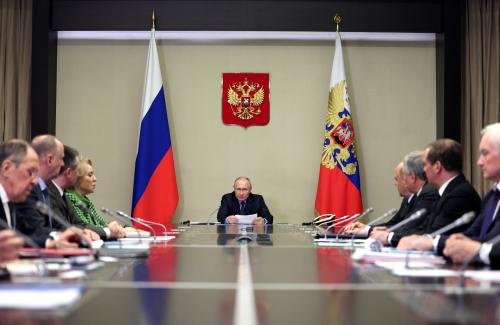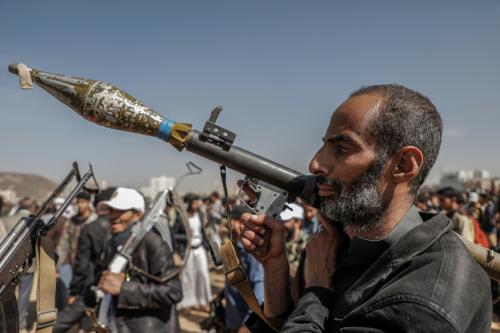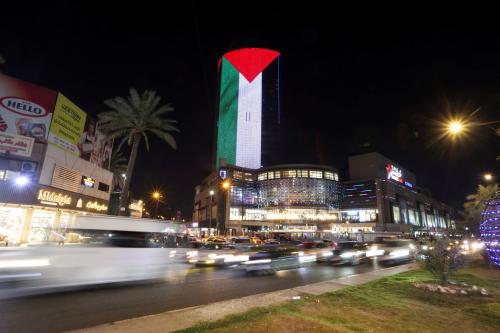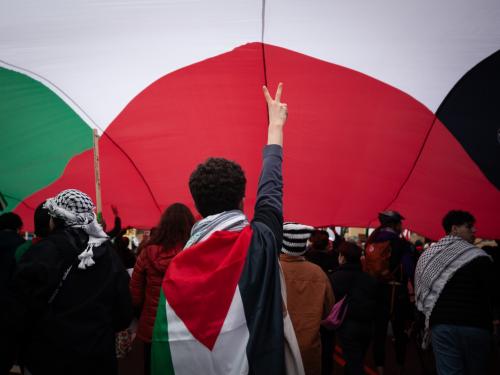This piece is part of the Center for Middle East Policy’s Israel-Gaza interviews series, in which leading experts unpack the conflict via in-depth Q&As.
Gaza's level of humanitarian need
KEVIN HUGGARD:
News reports describe acute shortages of food, water, and medicine, among other essentials, in much or all of the Gaza Strip. To start, can you explain the present level of humanitarian need in Gaza?
TANIA HARY:
According to the United Nations, 1.7 million people are internally displaced, or about 75 percent of Gaza’s 2.2 million residents. The displacement itself has led to immense challenges for the population and the humanitarian response in terms of shelter, food, sanitation, and health. The region has been experiencing heavy rains and cold temperatures, such that we’re seeing makeshift camps flooding, overflowing sewage, and families sleeping out in the open in wet, freezing conditions. In shelters run by the U.N. at their schools, each toilet and shower is shared by hundreds of people. Diseases associated with overcrowding, poor sanitation, and malnutrition like hepatitis A, diarrhea in children, and respiratory infections are rampant.
The latest Integrated Food Security Phase Classification (IPC) report, which looked at conditions in Gaza between November 24 and December 7, 2023, found that the entire population of Gaza is in “crisis or worse” levels of acute food insecurity. Within that, some 378,000 people (15 percent of the population) are at Phase 5 (catastrophic levels), and 939,000 people (40 percent of the population) are at Phase 4 (emergency levels). The IPC projected that this situation was expected to worsen to unprecedented levels of food insecurity by this February.
Evacuation orders and damage from bombardments have led to a situation where only 14 out of Gaza’s 36 hospitals are even partially functioning. These facilities lack basic medicine, anesthetics, and equipment as well as sufficient water and electricity supply. Doctors and other hospital staff are exhausted, and they and their families are themselves displaced, traumatized, and facing tremendous losses. Gisha, the Israeli not-for-profit organization where I am executive director, just collated a report on the impact of the war on women’s health specifically. For example, the U.N. reported that an average of 180 women are giving birth each day, facing the possibility of giving birth without anesthesia, without sufficient sanitary precautions in hospitals and clinics, or, if necessary, without surgical intervention.
This represents just a partial cross-section of the types of needs on an unprecedented scale that we are hearing about in Gaza.
Before October 7: How did goods and people enter Gaza?
KEVIN HUGGARD:
For context, can you describe the pre-October 7 situation, in which the movement of goods and people in and out of Gaza was restricted by an Israeli and Egyptian-enforced closure? How and where did essential goods enter Gaza under that system? Were there variations in the level of movement in recent years?
TANIA HARY:
Before October 7, two crossings were operating for the passage of people to and from Gaza: Erez Crossing with Israel in the north of the Gaza Strip and Rafah Crossing in the south, connecting Gaza to Egypt (you can see a map of the Gaza Strip and the relevant crossings here). In terms of the movement of goods, two separate crossings were operating: Kerem Shalom with Israel at the southern tip of the strip, and Salah a-Din Gate, a small crossing about four kilometers west of Rafah on the Egyptian border. Other crossing points with Israel had been gradually closed between 2007 and 2011 after Hamas took over internal control of Gaza in 2007.
There were three main categories of people who were eligible to cross at Erez Crossing: trader and worker permit holders, medical patients and their companions, and other “exceptional humanitarian cases”—for example, people visiting first-degree relatives who are gravely ill or those attending their weddings and funerals. Even with these narrow criteria, people were subjected to a harsh bureaucratic regime, including exceptionally long wait times (and sometimes nonresponses) to their permit applications and security blocks without reasoning provided. The rate of travel via Erez had increased in recent years, consisting mainly of workers who were accessing construction and agriculture jobs in Israel.
At Rafah Crossing, people could cross if they had foreign passports or visas to third countries, and there was a complex system of “coordination” involving payment for exit. Since around 2018, the rate of people traveling from Egypt increased, but people’s need to travel to Israel and the West Bank, where Palestinians have socioeconomic ties, was not met by exit from Rafah given that entry to the West Bank, even if through Jordan, requires Israel’s approval.
In terms of entry of goods via Israel, Israel removed restrictions it had enforced on everyday items and food from 2007-2010 after Hamas took over Gaza, but it continued to restrict what it referred to as “dual-use” items, i.e., items that it says have a civilian and military use. However, this list at times has included things like hospital beds, selfie sticks, and wood. Construction materials like wood were subject to greater scrutiny because of their potential use in building tunnels, but at the same time, several military operations created overwhelming humanitarian need for their quick entry in massive volumes. Today, Israel is still enforcing restrictions on items that can enter for the humanitarian response even when these items are critically needed, calling into question whether the restrictions are applied proportionately to the potential threat they pose. The marketing of goods from Gaza through Israel to markets in Israel, the West Bank, and abroad, which was vital for the economy in Gaza, was also subject to restrictions.
The entry of goods from Egypt through Salah a-Din Gate began in 2018 and gradually increased over the years, though it never reached the volume of entry that was seen at Kerem Shalom, from Israel, and access was limited to certain individuals and companies associated with the de facto Hamas government. Very few products exited, namely, scrap metal and batteries. The flow of goods to and from Salah a-Din was coordinated between Egypt and Israel, and restrictions that applied to “dual-use” goods were largely enforced there too.
The situation after October 7
KEVIN HUGGARD:
What happened to the movement of such goods in the weeks and months after October 7?
TANIA HARY:
The entry of goods from Israel was halted after October 7 and didn’t resume until December 17, following pressure from the United States. On October 8 and 9, some goods entered Gaza via Egypt, until Israel declared a total siege on the strip. Egypt, in coordination with Israel, only opened Rafah on October 21. Israeli authorities cited that only food, water, and medicine would be permitted for entry. On November 15, following a total block on fuel that lasted more than one month, the first fuel trucks were allowed into Gaza via Rafah. Israel said that fuel could be used by Hamas for firing rockets or for power generation in its tunnels, but fuel is also vital for civilian needs in the strip, particularly given the ongoing lack of electricity in the grid.
Kerem Shalom’s opening contributed to a slight rise in the entry of trucks initially, but at present, we are again seeing a decline. Currently, people in Gaza are completely dependent on the entry of aid and what is entering meets only a fraction of the needs in the strip. Much of Gaza’s agricultural lands, greenhouses, boats, and food production facilities, including bakeries and manufacturing companies, have been destroyed in Israel’s bombardments, so there is no local food production in the strip and very little agriculture.
In recent months, Israel began allowing some private sector trade via Rafah, with the U.N. indicating that the percentage of truckloads that have entered is 6 percent of the overall total since October 21.
Private sector activity via Kerem Shalom remains blocked as a matter of policy. Following October 7, some Israeli officials have made statements suggesting that Israel would never allow movement through its crossings and threatening to permanently cut the Gaza Strip off from Israel and thus also from the West Bank.
Is aid distribution meeting Gaza's needs?
KEVIN HUGGARD:
Under the present system, how and where is aid entering Gaza, how is it being distributed, and is it meeting the level of need?
TANIA HARY:
Aid, sourced internationally and from the Egyptian private sector, is entering Gaza through Rafah, after first being checked at the Nitzana Crossing with Israel, and Kerem Shalom. The international shipments come either via El Arish International Airport or Port Said in Egypt. Israel has thus far refused to allow in aid via its Ashdod Port, despite the port’s proximity to the Gaza Strip. However, Israel reluctantly agreed to make an exception to this policy after the United States requested flour be allowed to enter the strip via Ashdod.
The number of truckloads entering per day ranges between 80 and some 200, whereas before October 7 some 500 trucks entered Gaza per day. UNRWA, the United Nations Relief and Works Agency for Palestinian Refugees in the Near East, is the main U.N. agency distributing aid as it is housing more than 1 million people in its shelters. Some private sector activity via Egypt, as well as reselling of aid, is resulting in some products being available on the local market but prices are prohibitive for most of Gaza’s population, which was already impoverished before October 7.
Israel is continuing to block access to Gaza’s north. The U.N. reports that in January, 56 percent of humanitarian aid missions planned for northern Gaza and 25 percent planned for the middle area were denied access by the Israeli authorities. Distribution throughout the strip remains difficult due to ongoing hostilities, interceptions of convoys by desperately hungry crowds, destroyed roads, and other challenges. We haven’t been able to verify reports that Hamas’s authorities or operatives are taking the aid, though these types of obstacles are frequent in settings such as these.
The minimal amount of fuel needed to keep the emergency response going is not being met due to Israel’s policy of capping fuel entry at 189,000 liters per day. Prior to October 7, an average of some 374,000 liters of diesel entered Gaza daily via both Israel and Egypt, though this did not count what entered from Israel for Gaza’s power plant. Moreover, this was occurring at a time when the grid’s electricity was meeting about half of the demand.
Finally, many items needed for the humanitarian response such as water testing kits, spare parts, generators, pipes, anything with solar panels, and some medical equipment are being blocked by Israel.
Obstacles to aiding Palestinians in Gaza
KEVIN HUGGARD:
What are the most important obstacles to providing and distributing the needed level of aid to Palestinians throughout Gaza? Are the chokepoints on the Israeli side, inside the Gaza Strip, or both?
TANIA HARY:
First and foremost, the scale of need in Gaza cannot be addressed effectively while hostilities are ongoing. An immediate cease-fire is the only way to ensure safe, sustainable aid distribution. Convoys can’t move quickly and safely inside Gaza—whether because of bombardments, desperate crowds, or profiteering criminals seizing upon the trucks—there are shortages of trucks and drivers, and the need is so immense that the supply isn’t happening quickly enough to meet demand. There are also a number of policy decisions that Israel is making that are contributing to the humanitarian catastrophe, including not allowing goods to enter via Israeli ports or to be sourced in Israel and the West Bank, restricting the entry of items it classifies as “dual use,” and blocking access to the north of Gaza, where hundreds of thousands of people remain.
Israel can alleviate the crisis
KEVIN HUGGARD:
Lastly, beyond getting more aid into Gaza, what other measures are needed to address the urgent humanitarian crisis facing Palestinians in Gaza right now?
TANIA HARY:
Only a cease-fire will allow humanitarian actors to even begin to address people’s needs in the strip. Short of that, as an Israeli organization, we at Gisha are making the following demands of our government:
- Refrain from targeting civilians and civilian infrastructure, including hospitals and school shelters.
- Ensure effective deconfliction and safe humanitarian access, including access to the north.
- Restore electricity and full water supply and increase the entry of fuel, rather than capping it well below need.
- Allow goods to be sourced in Israeli and West Bank markets, permit the use of all Israeli ports, and allow goods to be sold and transported by the private sector.
- Remove unreasonable restrictions on entry of items deemed “dual use.”
- Refrain from attacks on telecommunications infrastructure.
It’s difficult at this moment to imagine the “day after,” but it’s clear that it will entail new challenges to rebuild and rehabilitate Gaza’s economy, not to mention address the war’s tremendous physical and mental toll on the population. The situation in Gaza was already difficult prior to October 7, in part because of long-standing restrictions on movement and access. Going forward, we need a new paradigm in which security is envisioned as a shared value for all the people in the region, and civilians have what they need to build a better future.





Commentary
The Gaza Strip’s deepening humanitarian crisis
February 22, 2024